Optimizing Green Computing Awareness for Environmental Sustainability and Economic Security as a Stochastic Optimization Problem
Abstract
:1. Introduction
2. Background and Related Work
2.1. Electronic Waste
2.2. Green Computing and Sustainable Development
2.3. Metaheuristic Algorithm for Optimal Green Computing Awareness
- establishing functional regulatory bodies;
- use of traditional media awareness;
- use of web-based social media;
- organizing workshops and seminars;
- establishing waste collection and quantification systems; and
- organizing a road walk campaign.
- Q = set of states that is finite
- A = set of actions that is not empty
- q0 ϵ Q = start state
- F Q = set of final states;
- Q A Q = finite set of transition between states; where
- p is a function ∂ [0,1] and all q ϵ Q; for all a ϵ A
- ∑ p(q, a, q') = 1.
- a0 = Knowledge gap analysis of computer end-users in Sub-Saharan Africa
- a1 = Identification of suitable campaign option for creating maximum awareness in the socio-cultural context of each African country
- a2 = Application of identified approach
- a3 = Evaluation of the impact of applied approach.
| Algorithm 1: Tabu Search |
|---|
s ← s0
sBestInitiative ← s
awarenessTabuList ← null
while (not awarenessSearchStoppingCondition())
awarenessCandidateList ← null
for(awarenessCandidate in searchNeighborhood)
if(not containsTabuElements(awarenessCandidate,
awarenessTabuList))
awarenessCandidateList ← awarenessCandidateList
+ awarenessCandidate
end
end
awarenessCandidate ←
LocateBestAwarenessCandidate(awarenessCandidateList)
s ← awarenessCandidate
if(fitness(awarenessCandidate) > fitness(sBestAwareness))
awarenessTabuList ←
featureDifferences(awarenessCandidate,
sBestAdmission)
sBestAwareness ← awarenessCandidate
while(size(awarenessTabuList) >
maxAwarenessTabuListSize)
ExpireFeatures(awarenessTabuList)
s ← awarenessTabuLIstFirstElements
end
end
end
return(sBestAwareness)
|
| Algorithm 2: Green Computing Awareness Maximization Function |
|---|
Max
Green Computing awareness
Subject to
Availability of funds
Access to network infrastructure
Literacy level
|
2.4. Related Work
3. Methodology—The e-Green Computing System
3.1. Requirements Analysis and Specification
3.2. System and Software Design
3.3. Implementation and Unit Testing
3.4. System Integration
3.5. System Verification and Validation
3.6. Operation Support and Maintenance
4. Results and Discussion
4.1. Results of Software Experiment
4.2. Results of End-Users Survey
4.3. Evaluation Threats
5. Conclusions
Acknowledgments
Author Contributions
Conflicts of Interest
References
- Michałowski, A. System aspects research of ecosystem services in the economy for sustainable development. Probl. Sustain. Dev. 2014, 9, 71–80. [Google Scholar]
- Ravikumar, V.; Chandrakumarmangalam, S. Impoverishment—The Threat for Sustainable Developments in Developing Countries. Probl. Sustain. Dev. 2016, 11, 105–112. [Google Scholar]
- Sztumski, W. Sustainable development—Unbalanced devastation of the environment and its consequences. Probl. Sustain. Dev. 2014, 9, 89–96. [Google Scholar]
- Kundzewicz, Z.W.; Kowalczak, P. Urban Flooding and Sustainable Land Management—Polish Perspective. Probl. Sustain. Dev. 2014, 9, 131–138. [Google Scholar]
- Zareba, A. Multifunctional and Multiscale Aspects of Green Infrastructure in Contemporary Research. Probl. Sustain. Dev. 2014, 9, 149–156. [Google Scholar]
- Murugesan, S. Harnessing Green IT: Principles and Practices. IEEE IT Prof. 2008, 10, 24–33. [Google Scholar] [CrossRef]
- Liu, H. Biofuel’s Sustainable Development under the Trilemma of Energy, Environment and Economy. Probl. Sustain. Dev. 2015, 10, 55–59. [Google Scholar]
- Kośmicki, E.; Pieńkowski, D. Renewable Energy and Socio-Economic Development in the European Union. Probl. Sustain. Dev. 2013, 8, 105–114. [Google Scholar]
- Hoeller, P.; Wallin, M. Energy Prices, Taxes and Carbon Dioxide Emissions; OECD Economic Studies No. 17, Autumn 1991; OECD: Paris, France, 2010; p. 92. [Google Scholar]
- The National Academies. Understanding and Responding to Climate Change; U.S. National Academy of Sciences: Washington, DC, USA, 2008. [Google Scholar]
- Venckauskas, A.; Stuikys, V.; Damasevicius, R.; Jusas, N. Modelling of Internet of Things units for estimating security-energy-performance relationships for quality of service and environment awareness. Secur. Commun. Netw. 2016, 9, 3324–3339. [Google Scholar] [CrossRef]
- Okewu, E.; Misra, S.; Okewu, J. Model-Driven Engineering and Creative Arts Approach to Designing Climate Change Response System for Rural Africa: A Case Study of Adum-Aiona Community in Nigeria. Probl. Sustain. Dev. 2017, 12, 101–116. [Google Scholar]
- Therese, K.; Albert, J. Stochastic Finite Automata: A Mathematical Model for Sequential Decision Making under Uncertainty. Int. J. Appl. Math. Model. 2014, 2, 1–14. [Google Scholar]
- Therese, K.; Albert, J. Stochastic Regular Language: A Mathematical Model for the Language of Sequential Actions for Decision Making under Uncertainty. Int. J. Math. Comput. Appl. Res. 2013, 3, 1–8. [Google Scholar]
- Silberholz, J.; Golden, B. Comparison of Metaheuristics; Springer Int’l Publishing: Cham, Switzerland, 2010. [Google Scholar]
- Glover, F. Tabu Search—Part 2. ORSA J. Comput. 1990, 2, 4–32. [Google Scholar] [CrossRef]
- Ciszek, M. Environmental ethics from a Thomistic-personalistic perspective (implications for the sustainable development concept). Probl. Sustain. Dev. 2014, 9, 97–106. [Google Scholar]
- Skowron, S.; Szymoniuk, B. Marketing and Sustainable Development. Probl. Sustain. Dev. 2014, 9, 39–46. [Google Scholar]
- Crespo, B.; Míguez-Álvarez, C.; Arce, M.E.; Cuevas, M.; Míguez, J.L. The Sustainable Development Goals: An Experience on Higher Education. Sustainability 2017, 9, 1353. [Google Scholar] [CrossRef]
- Gawor, L. Walery Goetel and the Idea of Sozology. Probl. Sustain. Dev. 2013, 8, 83–89. [Google Scholar]
- Kośmicki, E.; Pieńkowski, D. In Search of the Present Economy and Society Modernisation Concept (An Attempt to Explain the Main Problems). Probl. Sustain. Dev. 2013, 8, 115–123. [Google Scholar]
- Hack, S.; Berg, C. The Potential of IT for Corporate Sustainability. Sustainability 2014, 6, 4163–4180. [Google Scholar] [CrossRef]
- Moelders, T.; Szumelda, A.; Winterfeld, U.V. Sufficiency and subsistence—On two important concepts for sustainable development. Probl. Sustain. Dev. 2014, 9, 21–27. [Google Scholar]
- Wolczek, P. The concept of corporate social responsibility and sustainable development. Probl. Sustain. Dev. 2014, 9, 157–166. [Google Scholar]
- Radu, L.-D. Determinants of Green ICT Adoption in Organizations: A Theoretical Perspective. Sustainability 2016, 8, 731. [Google Scholar] [CrossRef]
- Okewu, E. Requirements Engineering in an Emerging Market. In Proceedings of the 2015 International Conference on Computational Science and Its Applications (ICCSA 2015), Banff, AB, Canada, 22–25 June 2015; Springer Publishers: Cham, Switzerland, 2015. [Google Scholar]
- Saha, B. Green Computing. Int. J. Comput. Trends Technol. 2014, 14, 46–50. [Google Scholar] [CrossRef]
- Mittal, P.; Kaur, N. Green Computing—A Survey. Int. J. Comput. Trends Technol. 2013, 4, 839–845. [Google Scholar]
- Shinde, S.; Nalawade, S.; Nalawade, A. Green Computing: Go Green and Save Energy. Int. J. Adv. Res. Comput. Sci. Softw. Eng. 2013, 3, 1033–1037. [Google Scholar]
- Investment Development Authority of Lebanon (IDAL). The ICT Market in Nigeria, 2015; IDAL: Beirut, Lebanon, 2015. [Google Scholar]
- Aggarwal, K.K.; Singh, Y. Software Engineering; New Age International Publishers: Delhi, India, 2008. [Google Scholar]
- Gorton, I. Essential Software Architecture, 2nd ed.; Springer: Berlin/Heidelberg, Germany, 2011. [Google Scholar]
- Pressman, R.S. Software Engineering: A Practitioner’s Approach, 7th ed.; McGraw-Hill: New York, NY, USA, 2009. [Google Scholar]
- Martin, R.C. UML Tutorial: Sequence Diagrams; Engineering Notebook Column; Springer Int’l Publishing: Cham, Switzerland, 1998. [Google Scholar]
- Sirohi, N.; Parashar, A. Component Based System and Testing Techniques. Int. J. Adv. Res. Comput. Sci. Softw. Eng. 2013, 2, 33–42. [Google Scholar]
- Beydeda, S.; Gruhn, V. An Integrated Testing Technique for Component-Based Software. In Proceedings of the ACS/IEEE International Conference on Computer Systems and Applications, Beirut, Lebanon, 25–29 June 2001; pp. 328–334. [Google Scholar]
- Host, M.; Regnell, B.; Wohlin, C. Using students as subjects—A comparative study of students and professionals in lead-time impact assessment. Empir. Softw. Eng. Int. J. 2000, 5, 201–214. [Google Scholar] [CrossRef]
- Runeson, P. Using students as Experiment Subjects—An Analysis on Graduate and Freshmen Student Data. In Proceedings of the 7th International Conference on Empirical Assessment & Evaluation in Software Engineering (EASE’03), Keele University, Staffordshire, UK, 8–10 April 2013; Linkman, S., Ed.; pp. 95–102. [Google Scholar]
- Sauro, J.; Kindlund, E. A Method to Standardize Usability Metrics into a Single Score; ACM, CHI: New York, NY, USA, 2005. [Google Scholar]
- Svahnberg, M.; Aurum, A.; Wohlin, C. Using students as Subjects—An Empirical Evaluation. In Proceedings of the 2nd International Symposium on Empirical Software Engineering and Management ACM, Kaiserslautern, Germany, 9–10 October 2008; pp. 288–290. [Google Scholar]
- Nielsen, J.; Landauer, T. A mathematical model of the finding of usability problems. In Proceedings of the ACM INTERCHI’93 Conference, Amsterdam, The Netherlands, 24–29 April 1993; pp. 206–213. [Google Scholar]
- Turner, C.W.; Lewis, J.R.; Nielsen, J. Determining usability test sample size. In International Encyclopedia of Ergonomics and Human Factors; Karwowski, W., Ed.; CRC Press: Boca Raton, FL, USA, 2006; pp. 3084–3088. [Google Scholar]
- Okewu, E.; Daramola, O. Component-based Software Engineering Approach to Development of a University e-Administration System. In Proceedings of the IEEE 6th International Conference on Adaptive Science and Technology (ICAST), Ota, Nigeria, 29–31 October 2014. [Google Scholar]

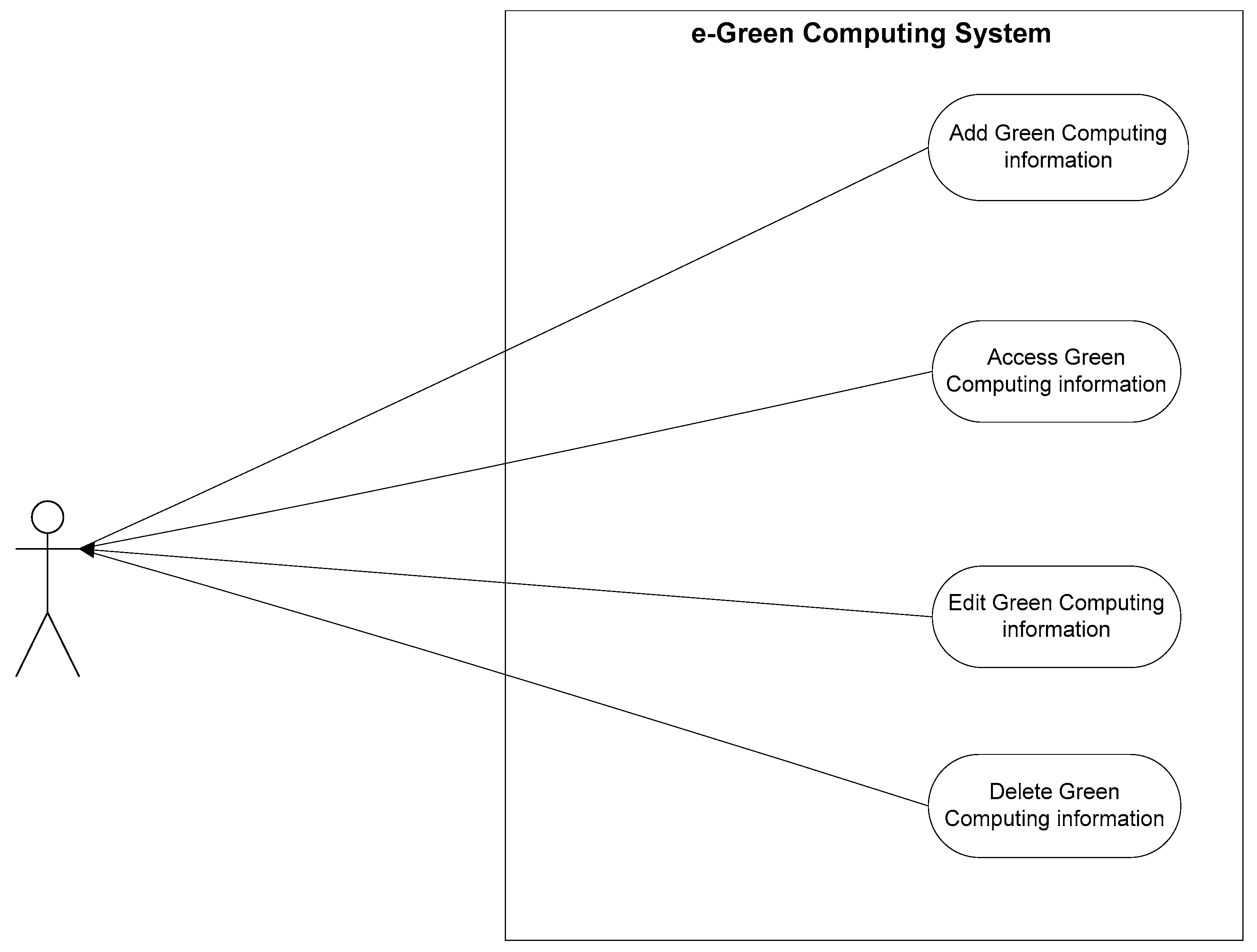
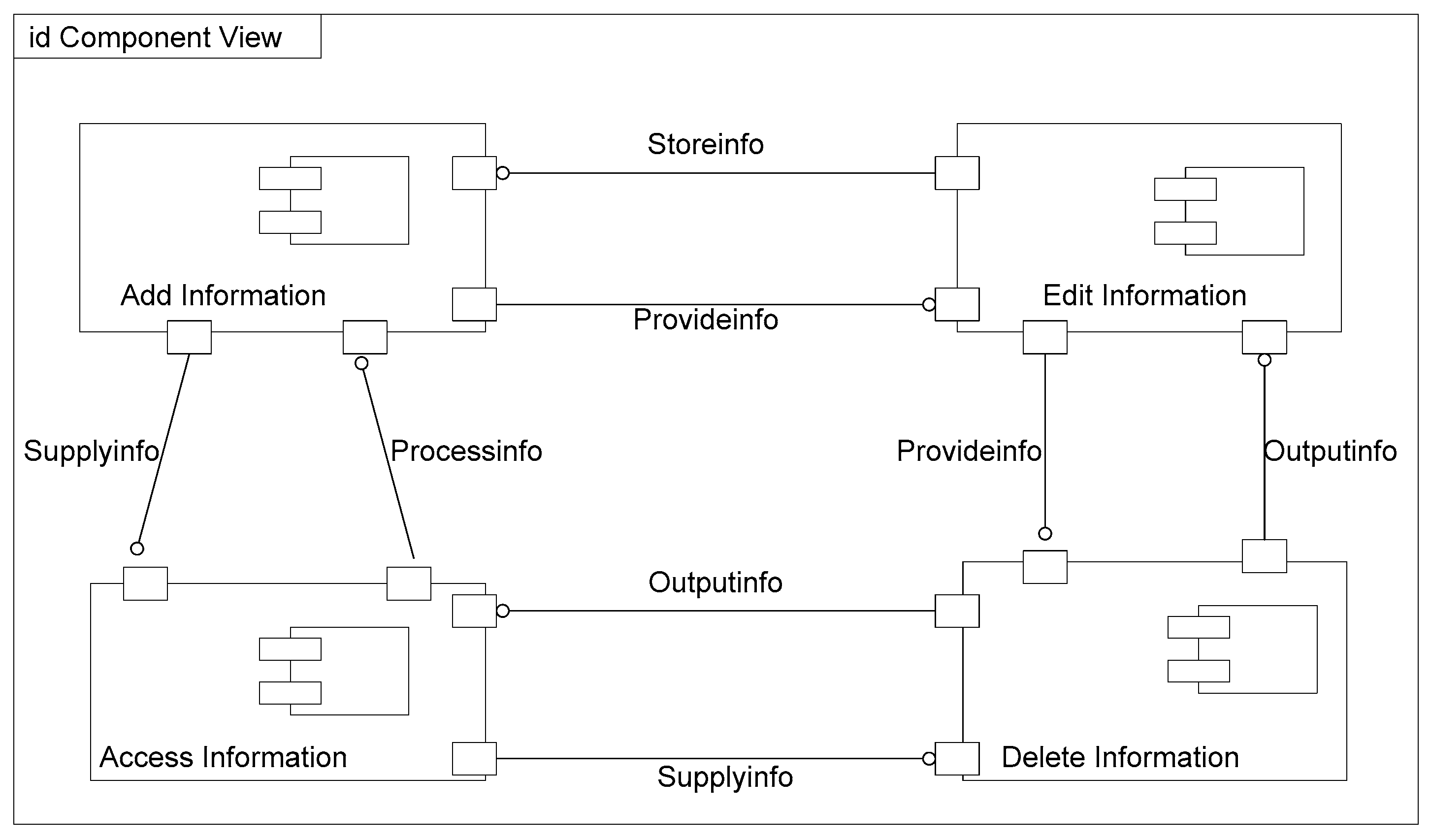
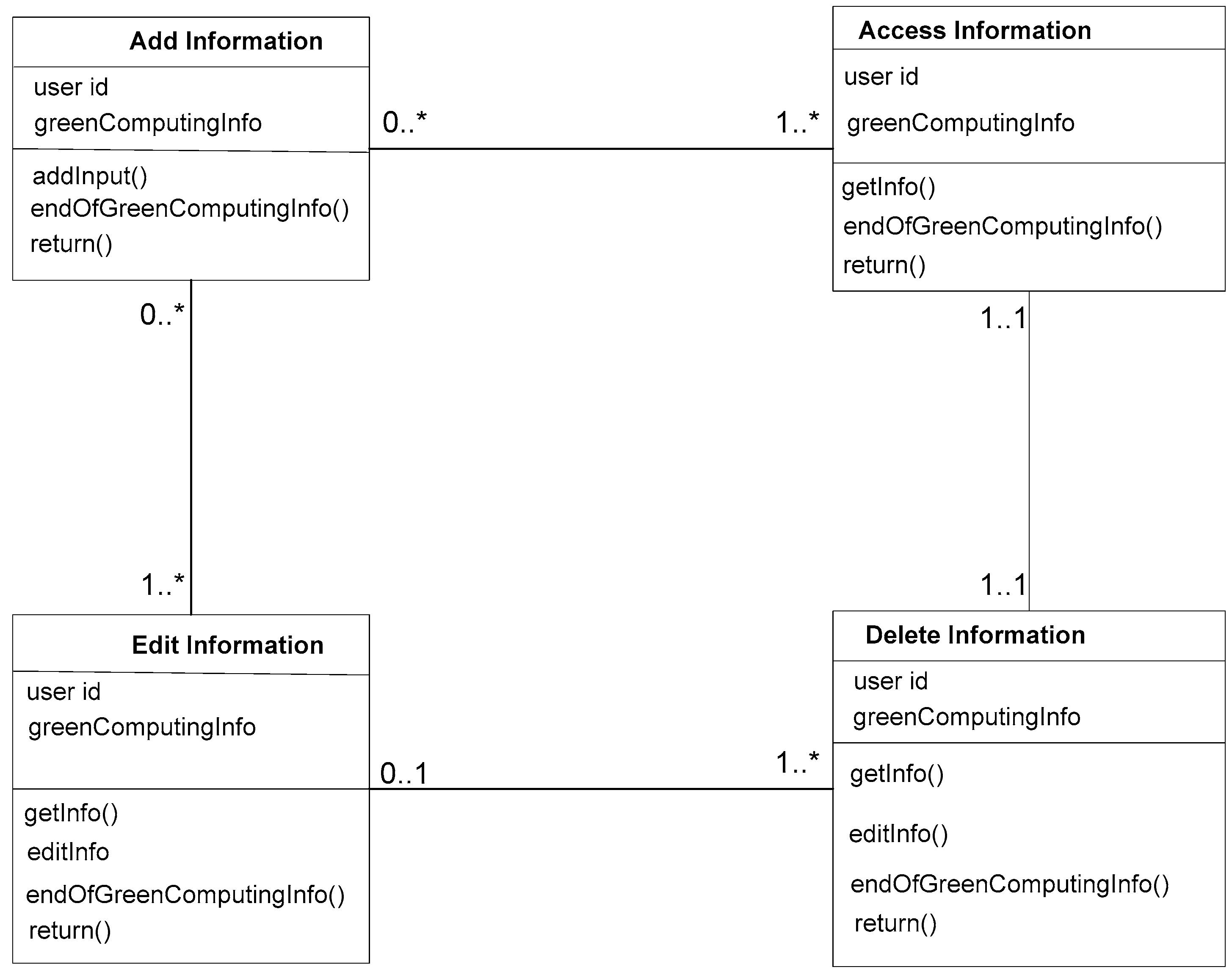
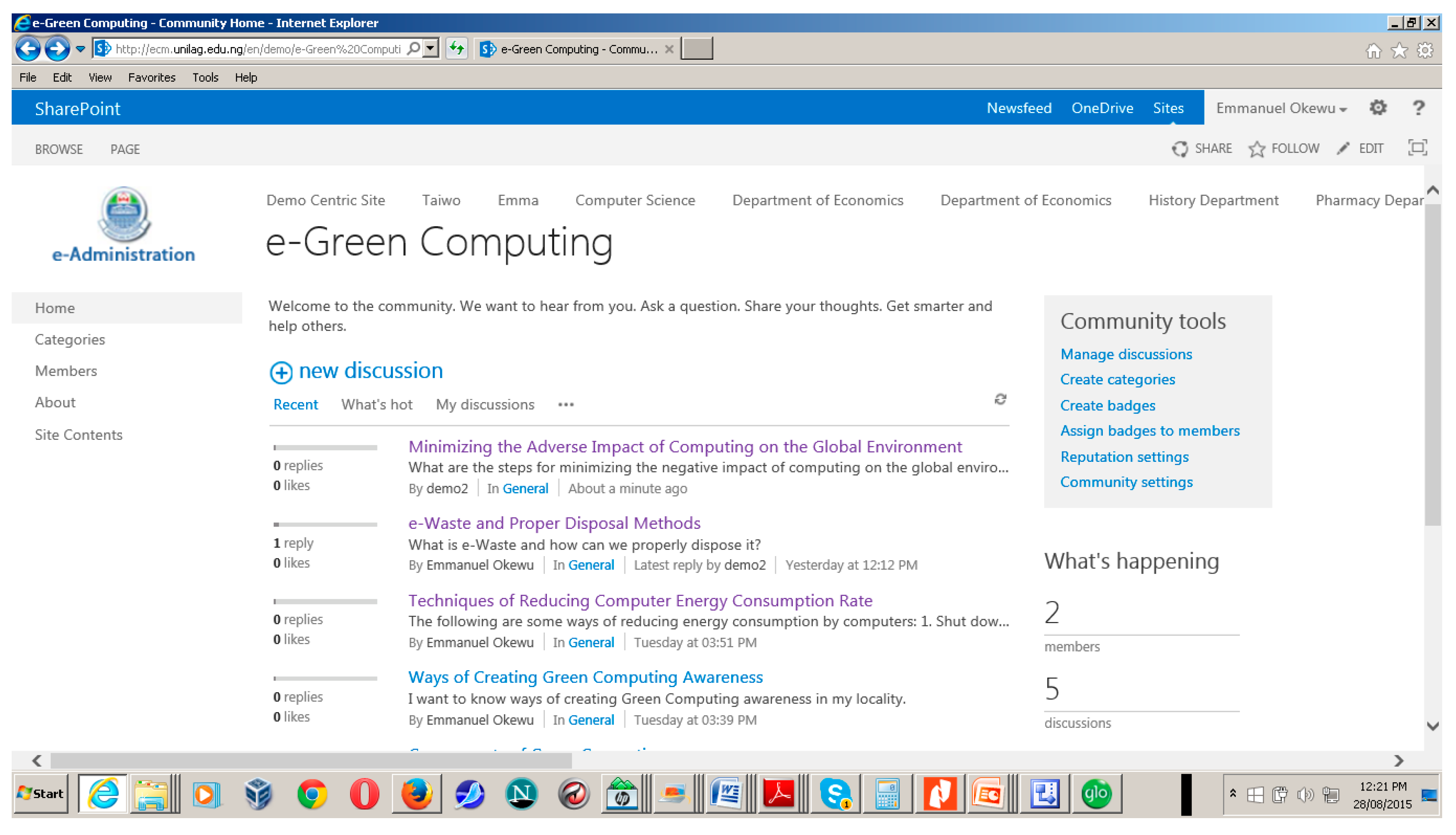
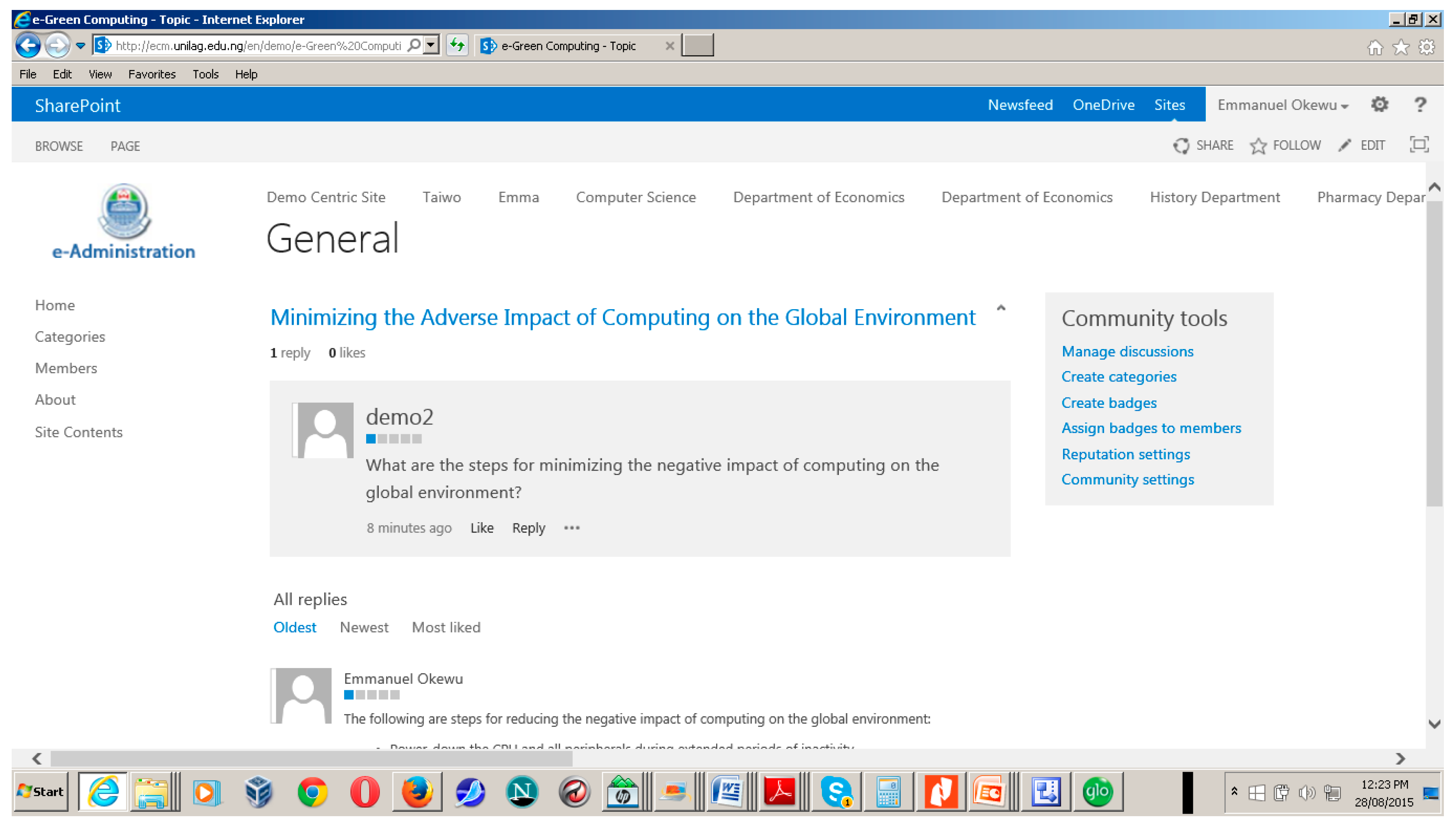

| SN | Objective | Methodology |
|---|---|---|
| 1. | To drive online real-time conversation on environmentally friendly computing in the African cyberspace | Design and implement an e-Green Computing system |
| 2. | To ascertain proposed system can bring about desired end-user behaviour | Verify and validate the e-Green Computing system |
| Requirement ID | Requirement | Brief Description |
|---|---|---|
| R01 | Add Information | The e-Green Computing system will allow computer users to add information on green computing techniques based on assigned rights and privileges |
| R02 | Access Information | The e-Green Computing system will allow computer users to retrieve and view information on green computing practices within assigned rights and privileges |
| R03 | Edit Information | The e-Green Computing system will allow computer users to edit information related to environmentally friendly computing in line with assigned rights and privileges |
| R04 | Delete Information | The e-Green Computing system will allow users to delete information from the database based on allocated rights and privileges |
| SN | Component | Function Points |
|---|---|---|
| 1. | e-Green Computing | Add Green Computing Info, |
| Access Green Computing Info, | ||
| Edit Green Computing Info, | ||
| Delete Green Computing Info |
| SN | Statement | Response | |||
|---|---|---|---|---|---|
| Yes | No | Abstained | Total | ||
| 1. | Familiar with Green Computing? | 3 (15%) | 15 (75%) | 2 (10%) | 20 (100%) |
| 2. | Green Computing is also referred to as environmentally sustainable computing? | 4 (20%) | 12 (60%) | 4 (20%) | 20 (100%) |
| 3. | The aim of Green Computing is to mitigate hazardous material and protect our environment. | 7 (35%) | 11 (55%) | 2 (10%) | 20 (100%) |
© 2017 by the authors. Licensee MDPI, Basel, Switzerland. This article is an open access article distributed under the terms and conditions of the Creative Commons Attribution (CC BY) license (http://creativecommons.org/licenses/by/4.0/).
Share and Cite
Okewu, E.; Misra, S.; Maskeliūnas, R.; Damaševičius, R.; Fernandez-Sanz, L. Optimizing Green Computing Awareness for Environmental Sustainability and Economic Security as a Stochastic Optimization Problem. Sustainability 2017, 9, 1857. https://doi.org/10.3390/su9101857
Okewu E, Misra S, Maskeliūnas R, Damaševičius R, Fernandez-Sanz L. Optimizing Green Computing Awareness for Environmental Sustainability and Economic Security as a Stochastic Optimization Problem. Sustainability. 2017; 9(10):1857. https://doi.org/10.3390/su9101857
Chicago/Turabian StyleOkewu, Emmanuel, Sanjay Misra, Rytis Maskeliūnas, Robertas Damaševičius, and Luis Fernandez-Sanz. 2017. "Optimizing Green Computing Awareness for Environmental Sustainability and Economic Security as a Stochastic Optimization Problem" Sustainability 9, no. 10: 1857. https://doi.org/10.3390/su9101857
APA StyleOkewu, E., Misra, S., Maskeliūnas, R., Damaševičius, R., & Fernandez-Sanz, L. (2017). Optimizing Green Computing Awareness for Environmental Sustainability and Economic Security as a Stochastic Optimization Problem. Sustainability, 9(10), 1857. https://doi.org/10.3390/su9101857






